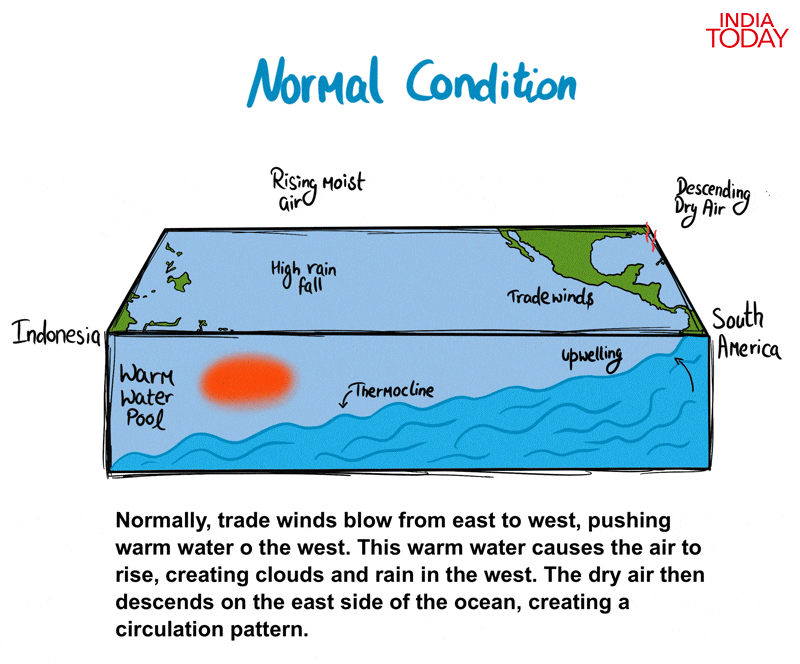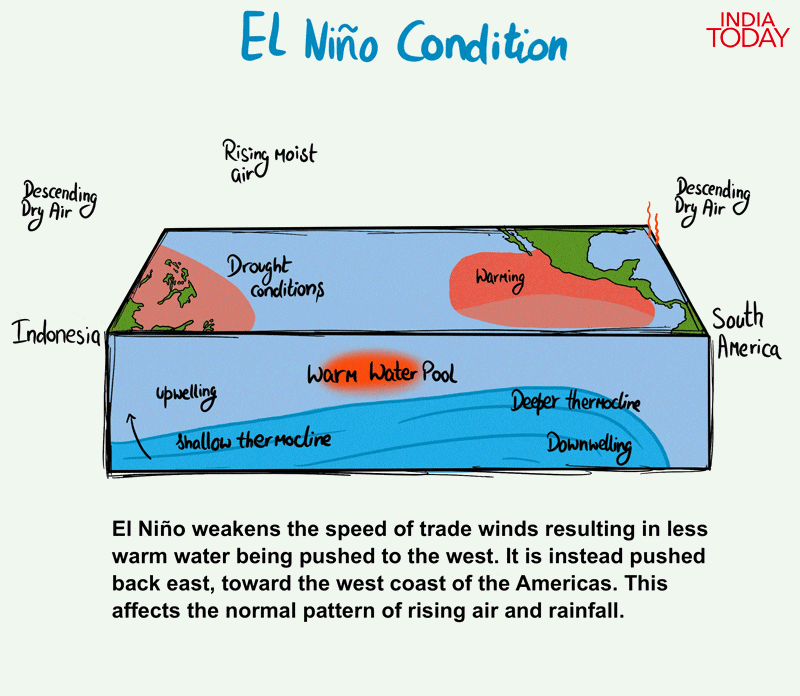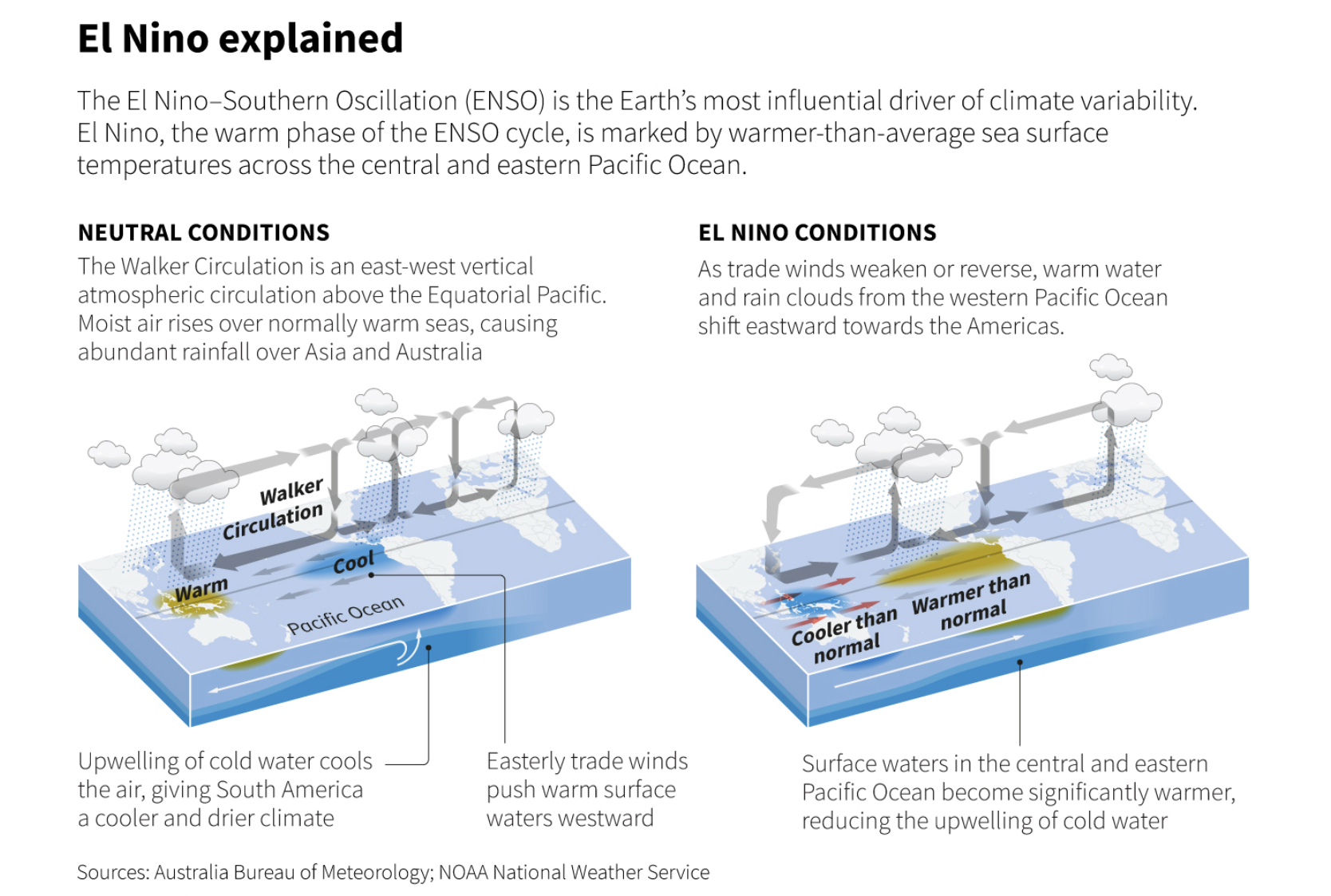ForumIAS announcing GS Foundation Program for UPSC CSE 2025-26 from 19 April. Click Here for more information.
Contents
| For 7PM Editorial Archives click HERE → |
Introduction
The National Oceanic and Atmospheric Administration (NOAA) recently announced the return of the El Niño phenomenon to the Pacific Ocean. El Niño is a climate pattern that emerges sporadically along the equatorial Pacific and is known for triggering global weather changes. The impacts of El Niño extend far beyond weather, influencing marine ecosystems, agriculture, and human health. As this powerful force returns, understanding the concept of El Niño and its widespread impacts becomes crucial for everyone.
What Is El Nino?
El Niño is a climate pattern that describes the unusual warming of surface waters in the eastern tropical Pacific Ocean. El Niño is the “warm phase” of a larger phenomenon called the El Niño-Southern Oscillation (ENSO). La Niña, the “cool phase” of ENSO, is a pattern that describes the unusual cooling of the region’s surface waters. El Niño and La Niña are considered the ocean part of ENSO, while the Southern Oscillation is its atmospheric changes. El Niño events occur irregularly at two- to seven-year intervals.
How will the formation of El Nino occur?

The formation of El Niño involves a series of interactions between the ocean and the atmosphere in the tropical Pacific. Here are the key steps in this complex process:
Normal conditions: Under normal conditions, the trade winds (which are part of the Earth’s general circulation) blow across the tropical Pacific from east to west. These winds push warm surface water towards the western Pacific (near Asia and Australasia), piling it up there. This leaves room for cold, nutrient-rich water to well up from the depths in the eastern Pacific (near South America).
Air circulation: The accumulation of warm water in the west heats the overlying air, making it moist and buoyant. This warm, moist air rises, leading to the formation of rain clouds. The rising air creates a low-pressure system in the west, and a high-pressure system forms in the east where cooler, drier air descends. This pressure difference reinforces the trade winds, completing what is known as the Walker circulation.
Weakening trade winds: The onset of El Niño involves a weakening or reversal of the trade winds. This can happen for various reasons, such as changes in the sea surface temperature distribution or atmospheric pressure patterns. The weakening of the trade winds is often initiated by an atmospheric phenomenon known as a westerly wind burst.

Spread of warm water: When the trade winds weaken, they can no longer push the warm water to the west as effectively. As a result, the warm water spreads from the western Pacific to the east. This process is known as a Kelvin wave. The spread of warm water to the east suppresses the upwelling of cold water near South America.
Feedback loop: The eastward spread of warm water further weakens the trade winds, creating a feedback loop that intensifies El Niño. This is because the warmer water warms the overlying air, which lowers the atmospheric pressure and weakens the trade winds.
Establishment of El Niño: As this feedback loop continues, the warm water in the eastern Pacific gets warmer, and the weakened trade winds get weaker. Eventually, a full-blown El Niño event is established, characterized by significantly warmer than average sea surface temperatures in the central and eastern Pacific.
What are the El Nino impacts in India?
El Nino impact on monsoon patterns and rainfall: El Niño can significantly impact the Indian monsoon, leading to fluctuations in rainfall patterns. During an El Niño year, India often experiences below-average monsoon rains, potentially causing drought conditions.
Droughts and water scarcity: Reduced monsoon rainfall can lead to water scarcity and droughts in many parts of India. These conditions can adversely affect agriculture, causing a decrease in crop yields.
Agriculture and food security: The irregular monsoon patterns during El Niño can impact agricultural yield, leading to potential food shortages and affecting farmers’ livelihoods.
Forest fires: During El Niño years, drier conditions may increase the likelihood of forest fires, especially in regions prone to such disasters. Forest fires can cause extensive damage to ecosystems and human settlements, leading to loss of biodiversity and property.
Health impact: El Niño can also lead to public health issues in India. For instance, drier conditions and heat waves can increase the risk of heat-related illnesses. Additionally, changes in weather patterns can also lead to the spread of vector-borne diseases like malaria and dengue.
Economic implications: The altered weather conditions can have significant economic implications. Reductions in agricultural output can increase food prices, while the costs associated with extreme weather events can strain the country’s economy.
Climate extremes: El Niño can contribute to other climate extremes in India, such as heatwaves and intense cyclones. These events can cause substantial damage to infrastructure, property, and human lives.
What are the El Nino impacts in regions outside India?

El Niño affects various regions across the globe in different ways. Here are some impacts observed in regions outside India:
North America: El Niño tends to suppress Atlantic hurricane activity, although there are exceptions depending on other climate factors.
South America: Coastal countries in South America like Peru and Ecuador can experience heavy rains and flooding. El Niño weakens the upwelling of cold, nutrient-rich waters along the coasts of South America, which can negatively impact marine ecosystems and fisheries.
Australia and Southeast Asia: These regions generally experience decreased rainfall during El Niño events, which can lead to droughts and significantly impact agriculture, water supply, and ecosystems. This decrease in precipitation can also heighten the risk of wildfires.
Africa: East Africa may receive more rain than usual, which could lead to flooding. Southern Africa may face drier conditions, which can lead to water shortages and impacts on agriculture.
Europe: The impacts on Europe are more uncertain and depend on how El Niño interacts with other climate patterns. However, it can potentially influence the strength and path of the jet stream, which could result in various weather anomalies in the region.
How global nations are planning to mitigate and combat El Nino impacts?
Creation of disaster risk reduction funds: Countries like Peru have created dedicated funds to tackle El Niño. Peru’s Disaster Risk Reduction Fund is specifically designated to prepare for and mitigate the potential impacts of El Niño. These funds are often allocated to various activities, including improving infrastructure to withstand extreme weather events, supporting early warning systems, and assisting recovery efforts after disasters.
Improved monitoring and early warning systems: The US-based National Oceanic and Atmospheric Administration (NOAA) continually invests in technology to monitor oceanic and atmospheric conditions better, helping predict an impending El Niño event. Early warnings from organizations like NOAA can help governments worldwide to prepare well in advance and implement strategies to minimize potential impacts.
International cooperation and policy frameworks: Many countries collaborate through international agreements and conventions to manage El Niño’s impacts. The Paris Climate Agreement, signed by 196 nations, underscores the importance of global action to address climate change, including phenomena like El Niño. These agreements may involve the sharing of information and resources, the development of common strategies, and cooperation on research and development efforts related to El Niño.
Climate change mitigation efforts: As the effects of climate change can potentially exacerbate the frequency and intensity of El Niño, efforts to mitigate climate change are an integral part of addressing El Niño. The UN’s Intergovernmental Panel on Climate Change (IPCC) plays a crucial role in guiding global policies related to climate change, including strategies to cope with El Niño events.
Adapting agriculture and infrastructure: In countries like India, which are heavily impacted by El Niño, there are ongoing efforts to adapt agricultural practices to be more resilient to changes in rainfall and temperature. This includes implementing irrigation facilities, diversifying crop types, and promoting weather-based crop insurance.
What should be done?
Promoting climate resilient infrastructure: Infrastructure development needs to factor in climate resilience, meaning that buildings, roads, and other infrastructure should be constructed to withstand extreme weather events like those brought on by El Niño.
Strengthening international collaboration: Countries should strengthen international cooperation to share knowledge, technology, and resources to mitigate the impacts of El Niño. Climate change has no borders, and global collaboration is crucial.
Climate change mitigation: Efforts should be heightened to reduce greenhouse gas emissions, as global warming can exacerbate the effects of El Niño. This includes promoting clean energy, reducing deforestation, and implementing sustainable practices in industries.
Adapting agricultural practices: In agriculture-based economies, there should be widespread education on the effects of El Niño on weather patterns to help farmers adapt their practices. This can include crop diversification, implementing irrigation facilities, and promoting weather-based crop insurance.
Building disaster management capacity: Countries should work on building their capacity to manage and respond to disasters caused by El Niño. This includes establishing effective disaster response strategies, conducting regular drills, and ensuring adequate resources are allocated to disaster management.
Conserving marine ecosystems: Since El Niño severely impacts marine ecosystems, it is crucial to conserve and protect these ecosystems as much as possible. This includes preventing overfishing, reducing pollution, and protecting marine habitats like coral reefs.
Sources: Business Standard, Bloomberg, Time, The Weather Channel, Climate.gov, Live Mint, NPR, TOI, Reuters, India Today, DTE, Financial Express and BBC
Syllabus: GS 1: Geophysical Phenomena: Important Geophysical phenomena




